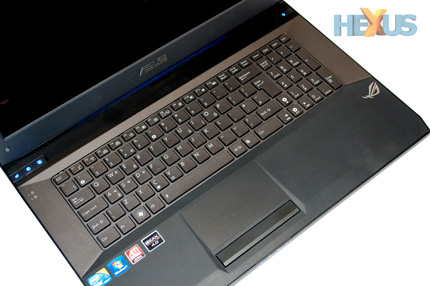User experience
Keyboard and trackpad
In keeping with what's quickly becoming an industry-wide trend, ASUS equips the G73JH with an inclined, backlit, chiclet-style keyboard.
Measuring 348mm in length, the keyboard's wide enough to incorporate a dedicated numpad and the majority of keys are large and well-spaced. There is a touch of flex beneath the centre of the keyboard, and the keys themselves are a little shallow for our liking, but the typing experience is generally pleasant.
Gamers who prefer not to use WASD, however, should note that the keyboard's slim arrow keys are very narrow.
Above the keyboard, you'll find the system's two stereo speakers - they're joined by by a bottom-mounted subwoofer - and four backlit buttons; power on the right-side edge, toggle switches for the lighting, turbo modes and display modes on the left-side edge.
The subtle lighting - which include a blue beam beneath the display - is nicely done, but our review sample shipped with a non-functioning keyboard backlight. It may be an isolated issue, but a quick Google search suggests otherwise.
According to other user reports - including some from ASUS's own support forums - a previous BIOS update (version 206) may have prevented the keyboard backlight from functioning. What's worrying is that the potentially-guilty BIOS update is still available to download and ASUS doesn't appear to have publicly acknowledged that such a problem exists.
Below the keyboard, the large multi-touch trackpad is positioned central to the a-z keys, and though it's responsive and comfortable to use, it's accompanied by one of the most disappointing mouse bars we've come across.
Requiring an overly-very firm press, the left mouse button in particular is very awkward to use. You could argue that most gamers will be using an external mouse, but it's a major oversight nonetheless, and one that tarnishes an otherwise good trackpad.
Ports and software
Whilst the keyboard and trackpad make good use of the chassis dimensions, the available selection of ports is surprisingly minimal.
On the right edge, the G73JH provides an eight-in-one card reader, two USB 2.0 ports, HDMI and VGA out, and a connector for the chunky bundled power adapter.
To the left, Gigabit Ethernet, an optical drive, two further USB 2.0 ports and headset/microphone connectors complete the line up. Considering the size of the system, we'd liked to have seen eSATA or perhaps USB 3.0, as well as an ExpressCard slot.
More isn't always better, though, as envisaged by ASUS's default software package. Straight out of the box, our review sample came pre-loaded with so many applications that Windows' add/remove a program utility actually took a while to populate.
Amid the list, you'll find a trial of Microsoft Office 2007, Windows Live Essentials, Google Chrome, two browser toolbars, CyberLink Power2Go, WinDVD, Trend Micro Internet Security, about a dozen ASUS utilities and a few trial games from Oberon Media - including Piggly and Dream Day Wedding Married in Manhattan.
It might be wishful thinking, but we'd love to see ASUS ship its gaming notebooks with less bloatware and perhaps one or two triple-A gaming titles instead.
Display, sound, noise and heat
One of the notebook's best features is its 17.3in, 1,920x1,080 display.
Teaming up with the Blu-ray drive to provide full-HD visuals, it's bright and vibrant thanks in part to a glossy finish, and although highly reflective, it's very enjoyable when gaming or watching a Blu-ray movie.
Black levels are surprisingly good, and audio output - provided by a Realtek ALC269 codec - does a decent job of completing the multimedia experience. Sound is crisp and clear, and there's a subtle of hint of bass from the token subwoofer.
It's by no means time to throw out your home cinema, but as far as notebooks are concerned, the G73JH provides excellent entertainment on the go.
Furthermore, the notebook stays remarkably cool and quiet, too. Under heavy load, the system chassis barely becomes warm and the cooling solution is only just audible. Considering the high-end components within, top marks to ASUS for implementation.













